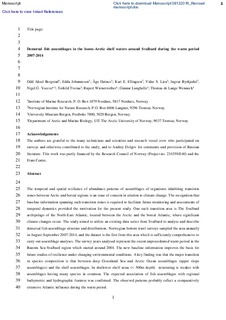Demersal fish assemblages in the boreo-Arctic shelf waters around Svalbard during the warm period 2007–2014
Bergstad, Odd Aksel; Johannesen, Edda; Høines, Åge Sigurd; Ellingsen, Kari Elsa; Lien, Vidar Surén; Byrkjedal, Ingvar; Yoccoz, Nigel Gilles; Tveraa, Torkild; Wienerroither, Rupert; Langhelle, Gunnar; Wenneck, Thomas de Lange
Peer reviewed, Journal article
Accepted version
Permanent lenke
http://hdl.handle.net/11250/2472132Utgivelsesdato
2017Metadata
Vis full innførselSamlinger
- Articles [3009]
- Publikasjoner fra CRIStin [3056]
Originalversjon
10.1007/s00300-017-2176-2Sammendrag
The temporal and spatial resilience of abundance patterns of assemblages of organisms inhabiting transition zones between Arctic and boreal regions is an issue of concern in relation to climate change. The recognition that baseline information spanning such transition zones is required to facilitate future monitoring and assessments of temporal dynamics provided the motivation for the present study. One such transition area is the Svalbard archipelago of the Northeast Atlantic, located between the Arctic and the boreal Atlantic, where significant climate changes occur. The study aimed to utilize an existing data series from Svalbard to analyse and describe demersal fish assemblage structure and distributions. Norwegian bottom trawl surveys sampled the area annually in August– September 2007–2014, and the dataset is the first from this area which is sufficiently comprehensive to carry out assemblage analyses. The survey years analysed represent the recent unprecedented warm period in the Barents Sea– Svalbard region which started around 2004. The new baseline information improves the basis for future studies of resilience under changing environmental conditions. A key finding was that the major transition in species composition is that between deep Greenland Sea and Arctic Ocean assemblages (upper slope assemblages) and the shelf assemblages. In shallower shelf areas (\500 m depth) structuring is weaker with assemblages having many species in common. The expected association of fish assemblages with regional bathymetric and hydrographic features was confirmed. The observed patterns probably reflect a comparatively extensive Atlantic influence during the warm period. Baseline _ Fishes _ Distributions _ Arctic _ Atlantic _ Svalbard
